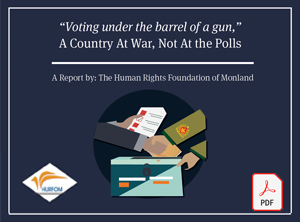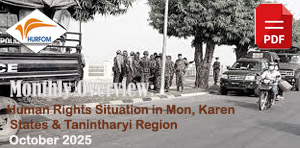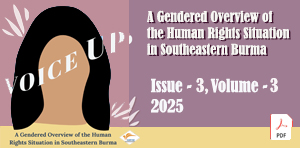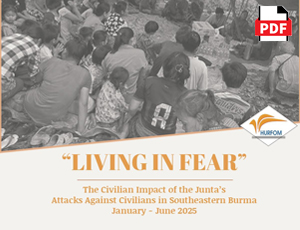Drugs problem in Burma and Drug Trafficking in Mon Areas
September 1, 2008
I.Burma: Well-known for Drug Production
Burma (Myanmar) continues to be second largest producer of opium after Afghanistan in this globe. Yet the military junta claims that it will free the country of opium cultivation by 2014. The fact – a corrupt military is known to turn a blind eye for it lines pockets and it is a main concern for the international community that whether they can end the drug problem in Burma, while the ethnic communities in various ethnic States express concern that the drug problems have increased.
Burma military junta – State Peace and Development Council (SPDC) – has quietly buried the ‘International Day against Drugs’ with the claim that the country would be drug free by 2014. A tall claim when the ground situation is exactly the reverse. The regime has claimed that its drug free campaign has cut down opium cultivation in the country where it has decreased from 140,000 hectares to 27,700 hectares in a decade.
This is for the record. The fact remains that gradually more areas are being brought under poppy cultivation with farmers into traditional farming opting for opium crops for the profits are much higher. And they have covert blessings of the regime which turns a blind eye for pockets of military officials are lined.
The regime which claims to be fighting drug production had its officials pull down posters on the anti drug day put up for the first time in key places in Myitkyina township, the capital of Kachin state in northern Burma, by Myitkyina University students. Why this lack of support to the awareness campaign in a state which is plagued by drug abuse? The answer is not difficult. The junta’s official machinery has a strong nexus with opium cultivators, drug manufacturers and traffickers.
Burma is the second largest opium producing nation after Afghanistan, according to the United Nation. Burma’s Minister for Home Affairs and Chairman of the Central Committee for Drug Abuse Control, Maj-Gen Maung Oo said the drug eradication programme had effectively brought down cultivation of opium in the country. But observers of the drug scene in Burma opine that there is very little progress.
In some areas where the country’s drug eradication programme is being implemented people have stopped cultivating poppy and have merely shifted to other places away from the public eye. In fact there have been instances where the military had advised growers not to cultivate poppy along the highways and roadsides and do so in the interiors. The regime has failed to provide alternative methods of livelihood to those did want to give up opium cultivation. So it is back to square one, the tall claims of the junta notwithstanding.
II. Amphetamine uses increase in Mon State
The origins of the recent influx of amphetamines into Mon State and the Thailand-Burma border via Mon State are unknown and widely debated. The Mon people claim the pills are produced by Karen ceasefire groups, while the Karen point fingers at the Mons who are main smugglers. But, a third contender is SPDC officials, who most people agree have a hidden hand in the illegal trade in some way. The question of amphetamine production is there fore a complex one, not confined to the illegal trade category.
Many Mon people have concerned about the amphetamine problem in their communities. A lot of mothers expressed their concerns that increased amphetamine production as a potential disaster for the future of Mon youths. However, use of amphetamine is becoming ingrained in the community, with many working men also using the drug regularly.
along. Trading of illegal pills is widespread in the area, especially during festivals where many people are around and eager to party, gamble and take risks.
One pill sells for 3,000 kyat in a village, and around 4,000 kyat in a school. Many Mon youth are now consuming amphetamine at an alarming rate. This trend is exacerbated by the absence of parents, many of whom work in neighboring Thailand leaving their children with elderly grandparents. According to a source from Mon State, grandparents have a harder time keeping track of their grandchildren, who frequently purchase amphetamines.
III. Amphetamines Threats to Community and Flow to Thailand
Recalling the Burma of a decade ago, Burma society today is markedly different. Drugs are threatening the society, from the older addicts who take pills to enhance their ability to work long hours down to the youths in the villages that take pills out of boredom and curiosity but soon find themselves addicted. The situation came similarly to Thailand, where many youths in the community openly using drugs even the suppression by the Thai government and military authorities have intensified.
The problems with a decaying society do not stop with drugs, although drugs are linked with villager unable to walk at night for fear of being attacked. In many villages there has been a gradual but definite increase in the number of motorcycles stolen, with many villagers certain the robberies were linked with drug use.
The uses of drugs have been widespread. Not only the youths, but also hard labourers in transportation service have used them and pose dangers for passengers. There have been several boat accidents in recent years along the Zami River from Three Pagodas Pass to Kya Inn Seikyi Township, some which resulted in the death of passengers.
A boat driver said, “If I take amphetamines, I can drive for two days without breaks for food or rest. Sometimes I visit Three Pagodas Pass to buy amphetamines. I was caught by the police once, with amphetamine pills in my pocket. Fortunately, the policeman knew me and just warned me not to use drugs too much because I might get into trouble. “
On July 25 this year a member of the Maternal and Child Welfare Association in Three Pagodas Pass, Daw Khin Myo Yi and Three associates were arrested at the Thai Army checkpoint, approximately 3 miles from Three Pagodas Pass in Thailand. She was allegedly carrying approximately 10,000 pills at the time of her arrest, according to a source from Three Pagodas Pass. In accordance with Thai law, sentencing increases in length when the offender is in possession of a high number of pills.
Daw Khin Myo Yi was also an information informer for the Burmese Army in Three Pagodas Pass. She tried to investigate amphetamines for the Democratic Karen Buddhist Army (DKBA) and it was here she became connected with drug smuggling. Following her arrest by the Thai Army, the Burmese Army stated she had become greedy and aimed to become rich quickly.
The Thai Army recognizes Three Pagodas Pass as a drug Zone, with local sources estimating approximately 100, 000 pills cross the Three Pagodas border into Thailand every day. As a result, the Thai Army has employed many locals as spies along the Thai-Burma border, and every month both Thai and Burmese people are arrested on suspicion of drug smuggling across the border.
Many believe that the Thai Army policies and ensuing efforts at drug eradication have not been successful, as they have not been able to enlist the assistance of the Burmese Army. “The Burmese Army often fails to arrest drug smugglers if they know them,” said a source from the New Mon State Party (NMSP).
He went on, “There are two main reasons for this. Firstly, if they arrest drug smugglers the result hits them in the rice pot, as they indirectly benefit from drug smuggling, and may find they can no longer afford food. The second reason is that there is no Burmese prison at Three Pagodas Pass so they are faced with the problem, and cost, of prisoner transportation of suspected smugglers to Moulmein prison.”
IV. Drug Suppression in the Border Areas
Although the New Mon State Party (NMSP) agreed ceasefire with Burmese Army, it has cooperated with Thai army and drug eradication authorities in suppression against drug traders. On May 16 Friday 2008, over 3,000 amphetamines were seized and a smuggler arrested by NMSP near Three Pagodas Pass (TPP) town on the Thai-Burma border.
Saw Moe Win, 38 years old, is from the Karen ethnic minority was arrested with evidence of smuggling amphetamines. According to the NMSP, the amphetamines were linked with the activities of the armed ceasefire group Democratic Karen Buddhist Army (DKBA).
The smuggler had hidden 18 packets of amphetamine underneath the jacket he was wearing. Each packet contained 200 pills. He was arrested while driving his motorbike across the NMSP checkpoint near the Thai-Burma border. The pills were MDMA, type WY+R, and according to the smuggler they originated in Pegu division.
This arrest was not an isolated incident in the area; in February the NMSP arrested a smuggler for attempting to traffic over 8,000 pills. The NMSP, in a bid to stop narcotics smuggling in their area of control set up the anti-drug department in 2002. Thai border military authorities have encouraged the NMSP to take action against narcotics smuggling in keeping with the Thai government’s policy of ‘War on Drugs’.
After the NMSP started taking action against narcotics smuggling, the TPP border, especially in the NMSP controlled areas there has been less drug smuggling and fewer arrests in the Thai military border check point. In the past, at least 10 smugglers were arrested yearly at the Thai military border check point and it was easier to access drugs on the TPP border.
The TPP border Township is under the administrative control of the Burmese military government. Ethnic cease-fire groups including the NMSP, Karen Peace of Front (KPF), Democratic Karen Buddhist Army (DKBA) are also based in TPP and have some control over the area. The majority of residents in TPP are ethnic people including Mon, Karen and Lao. Most of the families depend on logging and furniture trade for their survival.
At Thai Baht 150 per pill on the border of Thailand’s amphetamine prices are nearly double those in the neighboring Burma town of Three Pagodas Pass where a single pill is usually Thai Baht 90. Once inside they can then travel further into Thailand to places like Mahachai, one of the biggest Burmese migrant workers’ towns in Samut Sakhon provice near Bangkok, and where a single pill sells for at least Thai Baht 200.
“They (Burmese authorities of TPP) never used to administer any consequences for drug dealers when they arrested them with a small amount of pills, and they readily accepted bribes from dealers with larger quantities. Now they have no control over a problem that is increasing every day,” a resident close with TPP authorities said.
V. Beyond the Border: Drug Addiction in Mon Migrant Communities
There has been serious drug use problems among the Mon migrant workers in Malaysia, because many migrant workers wanted to commit in the hard works and to forget their loneliness and about far away from their families.
Even in the Annual General Meeting hosted by the Mon migrant community in Klang, near Kuala Lumpur, Mon migrant workers leaders were expressing to oppose drug uses and to elect those who did not use in their leading labour leaders. A meeting organizer said, “I propose that leading members lead the working committee by taking an oath to stay drug free and prove their worth as good role models.”
The Mon migrant workers communities in Malaysia are organized each other under the name of Mon Refugees Committee (MRC), as they believed that most of them fled from their homes not only because of economic purposes, but also because political persecution and human rights violations committed by SPDC authorities and troops of Burmese Army.
The general meeting was organized with objectives to help each other and aimed to gather together in order to support promoting development initiatives in their home villages in Mon areas southern part of Burma. MRC and Mon migrant workers has really helped the Mon communities in Mon areas to hold Mon National Day, build Mon national schools, set up clinics in local villages.
However, a serious negative impact to the migrant communities is a flow of drugs from Burma brought by smugglers by boats and other transports. Community workers say that the high rate of drug-abuse in compounded by the easy availability of a range of drugs circulation among the migrant community. However, the major drug traffickers and dealers are difficult to identify and health workers worry that those responsible may escape accountability leaving the innocent to face the consequences.
A story of Wan, from Kao Wao News
“I don’t want to think about home, I need to make my life happy here,” said Mehm Wan. Wan, 30, who left his village five years ago, flew in from Rangoon with a valid Burmese passport, but lost his legal status when he over-stayed. While some are successful at finding lefal status, many thousands of undocumented workers reside in the poor suburbs, many having to live oit in the open.
“My work is not stable and I am finding it impossible to send money home to feed my family.” Wan currently works in a car repair shop, but now faces a debilitationg drug addiction. Wan tells how he became addicted to drugs to escape loneliness and forget about his lived ones at home.
“My co-worker gave me a pill one day and said this will make you happy, I had no idea that I would become addicted to them,” he said. “Now I earn about 30 Riggit a day, but spend 20 for a drug called ‘Pea’ (Bean in Burmese language). I have to take 3 suits (9 tablets) to get high,” he explained.
An average drug addict spends about 6 US dollars a day on their habit, said social workers, noting that it had a serious impact on the families of addicts, draining them of financial resources.
Most Burmese face new social circumstances living away from their traditionally conservative village and are ill-prepared for the life of a migrant worker. Social workers say that the Burmese in Malaysia are in need of psycho-social programs that inform them about the risks associated with unprotected sex, as well as drug and alcohol abuse.
With ever greater number of young people leaving Burma to escape human rights violations and poor economic prospects, the governments of host countries that use their cheap labour to support their burgeoning economies need to implement education programs for young migrants who face many challenges living away from their families.
Growing Drug and HIV Problem
Another growing condern is the spread of HIV. A World Health Organization (WHO) reported in 2006 stated, “Illicit drug use and a lack of sex education among the immigrant population in Malaysia in fueling the spread of sexually transmitted diseases in the county.”
“There has been a complete lack of commitment by the governments of both Burma and Malaysia to develop community-based outreach services. As a result, drug abuse and HIV are increasing by the day,” said a Mon volunteer social worker, Nai Mon Nyan. He went on, “A major factor in its increase in living in limbo as an illegal migrant, but also the drugs are readily available on the street, especially among the community.”
“A couple from Yangon lives here and they don’t work like the rest of us in the factory. But they make more money than us by selling drugs, these tablets come from Penang. The pills, known as Pea, are sold for 3 Ringgit for one set (3 tablets) but some addicts use up to 6 sets a day,” said a social worker from Klang.
Opium use has a long history in Malaysia, especially among migrant Chinese labourers who brought the drug with them when they migrated, along with the British who controlled the opium trade early in the 20th century. But with the increased populiarity of drugs during the 1960’s and the Vietnam War, the number of those addicted to heroin grew sharply.
Despite a long history of drug abuse with opium addiction the response to illicit drug use today has been largely punitive with current goal of the Malaysian government to achieve a drug-free society by 2015. Malaysia’s war on drugs is an intensive effort of education, advertising, testing rehabilitation, harsh mandatory penalties for drug use and the death penalty for possession of relatively small amounts of heroin, cocaine or marijuana.
VI. Possible Involvement of SPDC Commanders in Drug Smuggling
Amphetamine comes from Shan State having good taste and it has high decree. There were different kind types of amphetamine such as YL, WZ and others. Some of Burmese businessmen today aware of the clue of business how to get rich quickly. And they worked like millionaires rich from Shan people Law Sa Hang and Khun Sa.
Firstly, they bought amphetamine from Shan State and they distributed to different areas in Burma. Today, the transportation is good in the country and the opium traders even can come to home. There some people who were aware of technique how to make amphetamine in Mon State. So, they do not have to go Shan State. They bought those machines from Thailand according to someone. Those who produce amphetamines were powerful as the Burmese army and the ethnic army group.
Accordingly to confidential sources, there are several places in Mon and Karen State producing amphetamines. He told me he went to Karen State in In-duu area of Pa-an Township, the ethnic army Karen group DKBA produced amphetamine in their battalion. There were people crowded in the battalion included men and women. Many of them were businessmen in town and those who smuggle Burmese migrants into Thailand.
A story of retired Burmese Army officers in drug trafficking:
Many Burmese businessmen in towns in Mon State approached the Burmese Generals and trafficking amphetamines. This was a true story in Kxxxx village businessman in Mudon Township. He was a former Burmese Army soldiers and he knew some of Burmese generals and senior officers. He was in prison several years for trafficking amphetamines. Many people from the community believed that after he was released from prison, he never stopped for trafficking drugs.
Fortunately, after he was released, he was used to continue his drug trafficking by a support of a General. The local police in town did not dare to capture him as they know his contact. There was one time the town police searched his house. Before the two police checked his house, he checked the police first then he allowed the police searched his house. The police did not find any amphetamine and lastly they found two cans of gold hide on the roof. The police have to go back as they didn’t see any thing. According to the source from the community, the police said they found him he wore army higher rank uniform on the way he was back bought amphetamine from Shan State. This was why they needed to find out his house. The police they found his uniform and they did not dare to say anything.
According to amphetamine trafficker in village, many Burmese general have linked amphetamine trafficking business. Even in the Burmese battalion, you can find amphetamines, he said. Those who trafficking amphetamine were relatives or family members of high rank military officers. When they traveled, they kept amphetamine in military cars and are not searched by polices. This was how the way amphetamine flows to different towns and cities in Burma.
According to source from the Mon ceasefire group, the Burmese army only said that drug smuggling was a business activity. They want many ceasefire group to deal in it and stop them speaking politics. On the other hand, when the military officers are transferred to the border areas, they always find out how they can get money for their families and this involves the taxes from drug smuggling in their controlled area.
Even so, they are not completely indifferent to the problem and with prominent arrests have been forced to accept it is a serious problem with major potential consequences. Most recently, in Rangoon several Burmese Generals’ family members have been detained for abusing their power and trafficking drugs. The Chief of the Bureaus of Special Operations Number One, Lieutenant-General Ye Myint resigned following the arrest of his son, Aung Zaw Ye Myint, on suspicion of drug trafficking and possession. With some movie stars and music celebrities also involved in Burma’s trade is heavily based with those in power and there fore places a great on the well-being of Burma.
VII. Slow Action: UN’s Crop Substitute Program
The world reported that Burma produced opium was the second largest of Afghanistan. According the UN reported on this year Burma produced opium still a largest amount it. However, the junta slammed the UN reported and claimed that the country has declined the opium production. The WFP’s involved in crop substitute program in Northern Burma, in Shan State, he UN believed that the substitute program might help the local people in Shan State growing bean or corns.
There were several reports from the Burmese activists reported the UN’s crop substitute programs weren’t successful for the Shan people. Many people were lack of food and they are poor and paved their life to be divorce or break up family. Some people said many people were get poor and for stress out and they used opium and they became drug addictions.
According to people from Shan State, Palaung ethnic, many poor people stop growing opium after WFP implement the crop substitute program. But there are number growing poor. Some people have to sell their farm because they are poor and another season was they do not have benefit from the crop substitute farm. Some rich people in the area bought the land and grow opium as cooperation with the local authority. When the local military authority crack downed the opium farm in the area. But, the authority did not target to the rich people farms. This is the drug link between the local rice people and the army.
Comments
Got something to say?
You must be logged in to post a comment.




















































